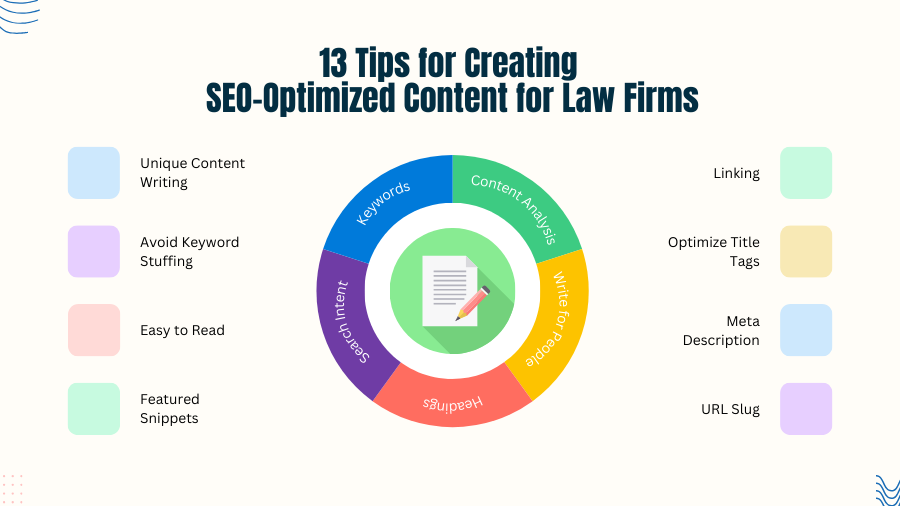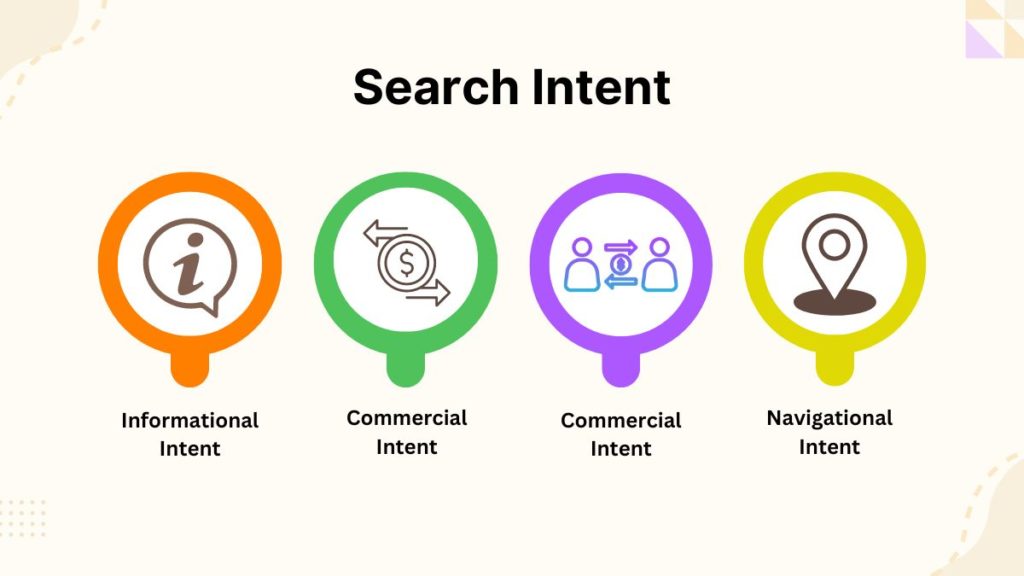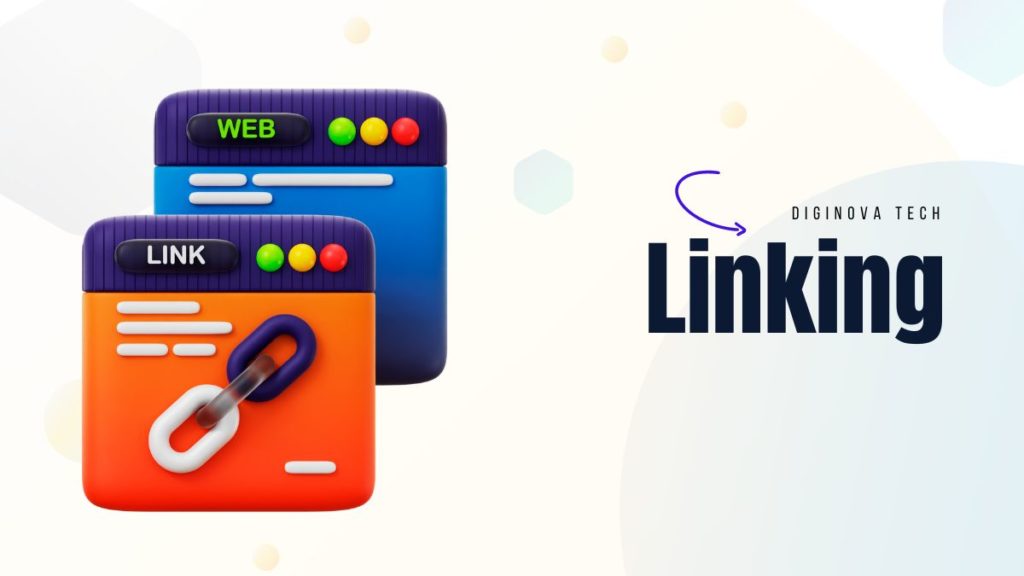
Ever wonder how some law firms seem to magically appear at the top of Google searches?
It’s not luck, it’s the power of SEO content writing!
SEO (Search Engine Optimization) writing is all about crafting content that Google loves and, more importantly, that potential clients find valuable. Think of it as creating a clear and informative guide that helps people understand their legal issues and showcases your expertise.
This guide dives into 13 easy-to-follow tips to help you master SEO content writing for your law firm.
So, get ready to watch your website climb the search engine ranks and attract a steady stream of new clients!
What Is SEO Content Writing for Law Firms?
People turn to Google every day with questions about everything from car accidents to family law. That’s where SEO content writing comes in for law firms.
Think of SEO writing as a bridge between your legal expertise and the people searching for it.
By understanding what kind of information users are looking for (their search intent), you can create content that directly addresses their needs.
This could be anything from blog posts explaining common legal situations to in-depth guides on specific practice areas.
The key is to create high-quality content that’s informative, easy to understand, and targeted toward the questions people are actually typing into search engines (keywords).
This way, when someone searches for a legal issue you specialize in, your law firm’s content is more likely to pop up at the top of the results page.
It’s a win-win: you help potential clients find the answers they need, and they discover your firm’s valuable legal services.
Why Is Legal SEO Content Writing Important?
Without SEO, your insightful legal content gets buried in the search engine results. Studies show click-through rates plummet after the first page. That means far fewer potential clients ever see your expertise.
Here’s the good news: SEO writing is your golden ticket to the first page. It helps your law firm’s content rise above the competition and attract users actively searching for legal help.
Think of it as a free marketing tool. By incorporating SEO best practices, you build a bridge between your valuable content and the people who need it most. SEO isn’t a magic trick, it’s a strategic way to amplify your reach and generate leads organically.
For more details on the costs associated with effective SEO and copywriting, check out our blog on “Law Firm Website Design, Copywriting and SEO Cost in 2024“
What is the Difference Between Legal SEO Writing and Content Writing?
While both legal SEO writing and content writing aim to inform and engage an audience, their primary goals and methods differ. Here’s a breakdown to clarify:
| Feature | SEO Writing | Content Writing |
| Focus | Improving website ranking in search results | Creating engaging and informative content |
| Keywords | Incorporates relevant keywords and phrases strategically | Not as heavily focused on specific keywords |
| Optimization | Optimizes website content for search engines through structure, meta descriptions, and title tags | Not as heavily focused on technical SEO optimization |
| Goal | Drives organic traffic to your website by targeting specific legal searches | Keeps website visitors engaged with informative and interesting content |
Think of SEO writing as the foundation. It uses strategic keyword placement to ensure your content appears in relevant search results. Content writing then builds upon this foundation by crafting informative and engaging pieces that convert those website visitors into potential clients.
13 Tips for Writing SEO-Optimized Content for Law Firms

Ready to take your law firm’s content to the top of search results?
Buckle up! We’ve got 13 powerful SEO tips to help your legal articles climb the Google ranks and attract more clients.
Let’s dive in!
1. Find Your Keywords for Law Firm

Before you start writing, you need to understand what people are searching for. This is where keyword research comes in!
- Primary Keyword: This is the main focus of your content. Choose a keyword that accurately reflects your legal expertise and has decent search volume.
- Secondary Keywords: These are related terms that support your primary keyword and help people find your content. Use a mix of high-intent (people looking for a lawyer) and informational keywords (people researching legal issues).
Use Tools
Several tools can help you with keyword research, including:
- Ahrefs
- SEMrush
- Ubersuggest
- Google keyword planner
When you’re first starting, target lower competition (KD) keywords for faster ranking. This will help you build momentum and establish your website’s authority.
Use Latent Semantic Indexing (LSI) keywords to sprinkle synonyms and related terms throughout your content for a more natural flow and improved search engine understanding.
Organize Your Keywords
Once you have your keywords, organize them in a spreadsheet. Include columns for:
- Primary Keyword
- Secondary Keyword
- Keyword Difficulty (KD)
- Search Volume
- User Intent and more

This organization will keep you focused and ensure your content targets the right audience.

How to Optimize Keywords on Your Law Website Contents
Strategic keyword use breathes life into your law blog’s SEO strategy.
Start by introducing your primary keyword naturally within the first 100 words to establish your content’s theme.
Don’t forget secondary keywords and relevant terms! Weave them seamlessly throughout headings and paragraphs, ensuring your content remains informative and engaging.
Remember, the goal is to create a natural flow of keywords, not force them in.
Avoid keyword stuffing at all costs, as it can hurt your rankings and reader experience.
2. Figure Out What Searchers Want: Search Intent

Remember, Google prioritizes showing the most relevant results to searchers.
To win the SEO game, you need to understand what people are hoping to find with their legal queries. This is all about search intent.
Here’s a breakdown of the different types of search intent:
- Informational Intent: Searchers are looking for information to educate themselves on a legal topic. Think “What are the grounds for divorce in [your state]?”
- Transactional Intent: Searchers are ready to take action, like contacting a lawyer. Examples include “Criminal defense attorney near me” or “[Practice area] lawyer consultation.”
- Commercial Intent: Searchers are comparing options before making a decision. They might be considering different law firms and their services.
- Navigational Intent: Searchers know exactly where they want to go, often a specific law firm’s website. (e.g., “[Law firm name] contact us”)
Why is Search Intent Important?
By aligning your content with the user’s intent, you increase your chances of ranking high and attracting the right clients.
For example, if someone searches for “car accident injuries,” they’re likely in the informational stage, wanting to understand their legal rights.
Your content should provide a clear explanation of personal injury law and the next steps, not push for a consultation right away.
Match search intent
Since you’re crafting legal content, focus on a mix of informational and commercial intent. Informational content educates potential clients about legal issues, while commercially-driven content positions your firm as the solution.
By matching search intent, you’ll create valuable content that resonates with your target audience.
Cover Everything Attorney Searchers Want to Know
Searchers often have specific questions and expectations within a broader topic.
Imagine someone searches for “car accident injuries.” They might be generally interested in their legal rights, but they likely also have sub-questions they expect to be answered, such as:
What types of damages can I recover?
How long do I have to file a claim?
What evidence should I collect?
By anticipating these sub-questions and incorporating them into your content, you provide a more comprehensive and valuable resource for searchers.
This not only improves user experience but also signals to Google that your content is truly in-depth and deserves a higher ranking.
3. Attorney Competitive Content Analysis
Before diving headfirst into content creation, take a strategic look at your competition. Here’s how to conduct a competitor analysis.
Identify Your Legal Competitors
Start by creating a list of law firms in your area that specialize in similar practice areas. Look for firms ranking well in search results for your target keywords.
Deep Dive and Analyze
Once you have your list, visit your competitors’ websites and blogs. Analyze their content for:
- Identify topics they cover well and areas where their content could be improved.
- See what types of content they produce (blogs, articles, infographics) and how often they publish.
- Analyze how they incorporate keywords throughout their content.
Creating a legal blog outline
Now, use your keyword research and competitive analysis to create a compelling blog outline.
Remember, Google loves unique concepts and fresh perspectives. Aim to go beyond what your competitors are offering and provide a valuable new angle on legal issues.
By understanding your competition and crafting unique content, you’ll position your law firm for SEO success.
4. Write Content for People, Not Just Search Engines
Here’s the truth: SEO is a powerful tool, but it’s only effective when it attracts real people. Keyword-stuffed legalese might get you noticed by search engines for a split second, but it won’t keep readers engaged or coming back for more.
Focus on Your Audience
Focus on creating clear, informative, and engaging content that tackles your audience’s legal concerns. Speak directly to their needs and questions in a way that’s easy to understand.
Quality Over Quantity
Think of it like this: You want potential clients to find your content, read it, and say “Wow, this is exactly what I needed!”

That’s where understanding your audience and writing for them comes in. So Don’t prioritize churning out tons of content at the expense of quality.
Earn free Backlinks
People link to valuable resources. When you create high-quality content that genuinely helps people, you naturally attract backlinks from other websites.
These backlinks act like votes of confidence in Google’s eyes, further boosting your SEO ranking.
The Google Happy Dance
Remember, Google’s ultimate goal is to deliver the best possible experience for users. When your content keeps visitors happy and engaged, it benefits everyone.
You establish yourself as a trusted legal resource, Google gets happy users, and potential clients find the information they need.
Focus on creating content that informs, educates, and resonates with your target audience. That’s the recipe for true SEO success.
5. Create Quality & Unique Lawyer’s Website Content Writing
Content is king, and that’s especially true for SEO. No amount of technical trickery can replace the power of high-quality, informative copywriting. But what makes Lawyer’s Website content truly “quality”?
The Pillars of Quality Content:
- Accuracy
- Value:
- Originality and Uniqueness
- Engagement
Google actively rewards content that brings something new to the table. Here are some ways to add originality and make your legal content stand out:
If you’re not a legal expert yourself, interview seasoned attorneys in your practice area. This allows you to condense their knowledge into valuable content while showcasing diverse perspectives.
When possible, draw on personal experience.
For instance, if writing about a specific legal process, share your own experience navigating it (while adhering to ethical guidelines).
Back up your content with unique data gained through surveys, experiments, or case studies. This adds a layer of authority and credibility.
Don’t settle for surface-level information. Dig deep into your topic by reading industry publications, conducting in-depth research, and exploring primary sources.
Don’t be afraid to challenge conventional wisdom in the legal field. Express your well-reasoned opinions and back them up with evidence from your expertise or experience. This can spark interesting conversations and establish you as a thought leader.
6. Avoid Keyword Stuffing in Your Legal Web Content

Keywords are essential for SEO, but using them strategically is key. Google needs keywords to understand your Legal Web content’s topic and rank it accordingly.
However, there’s a fine line between strategic integration and a technique called “keyword stuffing” that you should avoid at all costs.
What is Keyword Stuffing?
Keyword stuffing is the inauthentic practice of cramming your content with keywords in an unnatural way.
It’s an attempt to manipulate search engines into ranking your content higher.
Here’s an example of what not to do:
Bad Example: “If you’re looking for a [legal service] attorney in [your city], then [your law firm] is the perfect choice! We specialize in [legal service] law and have a team of experienced [legal service] attorneys who can help you with your [legal issue]. [Legal service] is a complex area of law, and you need an attorney who knows what they’re doing. Contact [your law firm] today for a free consultation!”
So how do you incorporate keywords effectively?
Integrate your researched keywords naturally throughout your content.
Write for humans first, ensuring your content is clear, informative, and addresses your audience’s needs. The keywords should seamlessly flow within the text, not disrupt the reading experience.
7. Structure Law Firm Website Content with Clear Headings

Headings are your secret weapon for clear, SEO-friendly legal content. These miniature titles (H2-H6) break down your content into digestible sections.
Think of subheadings as a roadmap for your content. You’ll start with a catchy title that includes your primary keyword (H1).
Then, use relevant H2 subheadings to address the main points within your content. H3 subheadings further break down each H2 section, and so on (H2s support H1, H3s support H2s, etc.).
This hierarchical structure makes your content clear and organized, both for readers and search engines.
Helping Search Engine Crawlers?
Subheadings act as signposts for Google’s crawlers, helping them understand your content’s structure and key points. Imagine crawlers as scanners skimming your content.
H1 provides an overview, while H2s, H3s, and H4s break down the subtopics within the article.
By using clear subheadings with relevant keywords, you guide crawlers toward the valuable information within your content and increase your chances of ranking higher in SERPs (Search Engine Results Pages).
8. Make Your Legal Content Easy to Read
Readability is a cornerstone of effective SEO writing. If your content is complex and dense, readers will bounce off quickly, sending a negative signal to Google about your content quality.
Here’s how to craft clear, readable content that keeps readers engaged:
Embrace Scannable Content:
- Short Sentences & Paragraphs
- Simple & Clear Language
- Visual Appeal
Structure for Clarity:
Utilize subheadings to organize your content and guide readers through key points.
Formatting for Readability
It is better to use the following formatting options wherever possible:
- Bullet Points, Numbering & Lists
- Table
- quotations
- Bold & italic
- White Space
- Images & Infographics
- Consistent Font & Size
- Hyperlinks
- Highlight Boxes
- Readable Fonts
- Line Spacing

By creating clear, concise, and visually engaging content, you’ll improve user experience, encourage readers to stay on your website, and send positive signals to search engines, ultimately boosting your SEO ranking.
9. Optimize Your Attorney Content for Featured Snippets

Featured snippets, those golden answer boxes at the top of search results, offer incredible opportunities to boost your law firm’s visibility. By optimizing your legal content, you can increase your chances of claiming these coveted spots.
Understanding Featured Snippets
When targeting keywords, check for existing featured snippets.
Analyze their format (paragraph, list, table) and the information they display. This reveals what Google and users are looking for.
Tailor your content to match the current featured snippet format. If it’s a list, use a list in your content as well.
Provide clear and concise explanations in simple, easy-to-understand language. This increases your chances of Google selecting your content for the snippet.
Crafting Content for Snippets
When creating content that targets featured snippets, aim to answer the search query directly and thoroughly within your content.
Use relevant headings (H1 or H2) to clearly state the question you’re addressing.
Consider formatting your answer sections using numbered or bulleted lists for improved readability and scannability.
Engage users by starting your answer sentences with action verbs like “click” or “select.” Finally, if your target keyword requires a definition, keep your answer concise (under 49-58 words) for optimal snippet display.
10. Link Within and Beyond Your Law Firm’s Content

Strategic linking throughout your website’s blog posts strengthens your SEO and enhances the user experience.
By connecting your content through relevant links, you guide visitors to explore various legal topics offered by your firm.
This not only showcases your expertise but also helps search engines understand your website’s structure and content hierarchy.
Internal Linking
Focus on internal linking first. Link to relevant blog posts that provide deeper dives on related topics, keeping users engaged and learning more about your legal services.
This reduces bounce rates (users leaving after one page) and positions your firm as a comprehensive legal resource.
External Linking
While internal linking is crucial, consider incorporating external links sparingly.
Linking to high-authority external resources on relevant topics demonstrates your commitment to a well-rounded user experience and strengthens your credibility as a trustworthy legal source.
Remember, the key lies in using natural language within your link text (anchor text). This text should accurately reflect the content users will find when they click, avoiding generic phrases like “click here.”
By implementing a strategic linking strategy, you create a user-friendly website, improve website navigation, and potentially boost your SEO ranking.
11. Optimize Your Legal Website’s Title Tags for More Clicks

Your title tag is prime real estate in search results, acting as both a beacon to search engines and a first impression for users.
Here’s how to craft compelling title tags for your Legal website content:
SEO & User Engagement
Keyword Focus: Include your primary keyword at the beginning of the title tag for search engine relevance.
Click-Worthy Content: Craft enticing titles using power words, numbers, and brackets to encourage clicks.
Character Count: Aim for titles under 60 characters to avoid truncation in search results.
Example: “How to Win Your Personal Injury Case (Free Consultation)” (Under 60 characters, includes keyword, uses power word “Win” and a call to action “Free Consultation”)
Engagement Strategies
Titles incorporating numbers like “5 Steps to…” or “Top 10 Tips…” grab user attention.
Highlight the value you offer by mentioning a free consultation, guide, or specific service in your title.
Spark user curiosity with open-ended questions or titles that evoke emotions.
Boost Click-Through Rates (CTR)
Studies suggest a higher Click-Through Rate (CTR) can lead to improved rankings. Craft compelling titles that entice users to click.
Weave in emotions or intrigue to pique user interest and encourage them to click and discover more.
By implementing these tips, you can create title tags that are both SEO-friendly and user-engaging, leading to more clicks and improved visibility for your law firm’s content.
12. Write a Compelling Meta Description

Meta descriptions, while not directly affecting Google rankings, are powerful tools for attracting user clicks.
Here’s how to craft descriptions that entice potential clients to visit your law firm’s content:
Boost Click-Through Rates (CTR)
Craft unique and informative meta descriptions for every page on your website.
Write descriptions that directly address potential clients, sparking their interest and encouraging them to click through and learn more.
Structure and Content
Use active voice and action verbs like “learn more,” “find out,” or “discover” to create a sense of urgency and encourage user engagement.
Keep your meta descriptions concise, ideally within 155 characters, ensuring they’re fully shown in search results. Naturally, incorporate your primary keyword within the meta description to signal relevance to user searches.
13. Optimize Your URL Slug

The URL slug, the final portion of your webpage’s URL, plays a role in how search engines understand your content.
Search engines use URL slugs to grasp your content’s topic. Optimized slugs improve the chances of your content appearing in relevant search results.
Here’s how to craft optimized slugs for your law firm’s website:
- Target Keyword Integration: Incorporate your primary keyword naturally within the slug to signal relevance to user searches.
- Hyphens for Separation: Use hyphens (-) to separate words within your slug. This is the standard practice for URL readability.
- Timeless Content: Avoid including dates in your slugs, as this can make your content appear outdated over time.
- Concise & Descriptive: Strive for concise and descriptive slugs that accurately reflect your content’s topic, without being overly long or confusing.
By following these best practices, you create optimized URL slugs that enhance your legal website’s SEO by improving search engine understanding and potentially boosting your ranking in search results.
Conclusion for Law Firm’s Seo Content Writing
By following these 13 SEO tips, you can transform your law firm’s blog into a powerful tool for attracting new clients and establishing your expertise.
Remember, informative content, strategic keyword use, and a user-friendly website are all key ingredients for SEO success.



